-
Countries
-
Data and Analysis
-
Special Focus
-
Crisis Responses
Return migration

Contact
DTM South Sudan, SouthSudanDTM@iom.int
Language
English
Location
South Sudan
Period Covered
Nov 01 2019
Mar 31 2020
Activity
- Mobility Tracking
- Baseline Assessment
IOM’s Displacement Tracking Matrix (DTM) and WHO's Health Service Functionality (HSF) teams collaborated to produce this joint analysis on health care access for internally displaced persons (IDPs) and returnees in South Sudan. The interactive report provides a countrywide summary of gaps in access to functional health facilities by IDPs and returnees. To view the interactive report, please unzip the attachment and open the html document with any web browser (e.g. Firefox, Chrome, Internet Explorer).
Important to note
- Health service availability data was compiled by WHO and reflects health service availability reported as of 31 March 2020.
- Data on Internally displaced persons (IDP) and returnee settlements was collected by IOM DTM in November 2019 as part of round 7 of Mobility Tracking.
- There are 164 health facilities that are functional according to HSF records, but for which GPS coordinates are unavailable and are not included in this analysis.
- WHO's health service availability data summarizes available information and was not collected using formal surveys and sampling methods, meaning there are data gaps and difficult to access and non-functional facilities not supported by partners are likely underrepresented
Questions or comments
- For any questions on the analysis or health service availability data, please contact Malick Gai gaim@who.int, HSF Project Manager, or Ryan Burbach rmburbach@gmail.com, HSF Technical Adviser
- For any questions on IOM DTM data on IDP and returnee settlements, please contact southsudandtm@iom.int
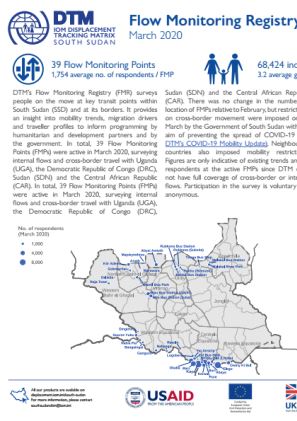
Contact
DTM South Sudan, SouthSudanDTM@iom.int
Language
English
Location
South Sudan
Period Covered
Mar 01 2020
Mar 31 2020
Activity
- Flow Monitoring
DTM’s Flow Monitoring Registry (FMR) surveys people on the move at key transit points within South Sudan (SSD) and at its borders. It provides an insight into mobility trends, migration drivers and traveller profiles to inform programming by humanitarian and development partners and by the government. In total, 39 Flow Monitoring Points (FMPs) were active in March 2020, surveying internal flows and cross-border travel with Uganda (UGA), the Democratic Republic of Congo (DRC), Sudan (SDN) and the Central African Republic (CAR). There was no change in the number or location of FMPs relative to February, but restrictions on cross-border movement were imposed on 24 March by the Government of South Sudan with the aim of preventing the spread of COVID-19 (see DTM’s COVID-19 Mobility Update). Neighbouring countries also imposed mobility restrictions. Figures are only indicative of existing trends among respondents at the active FMPs since DTM does not have full coverage of cross-border or internal flows. Participation in the survey is voluntary and anonymous.
The summary dataset for March 2020 is available at this link.
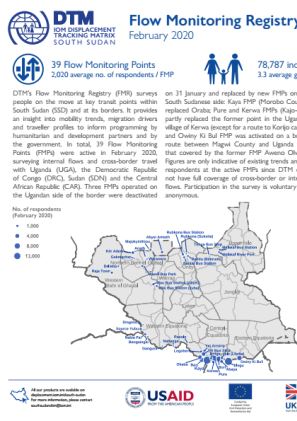
Contact
DTM South Sudan, SouthSudanDTM@iom.int
Language
English
Location
South Sudan
Period Covered
Feb 01 2020
Feb 29 2020
Activity
- Flow Monitoring
DTM’s Flow Monitoring Registry (FMR) surveys people on the move at key transit points within South Sudan (SSD) and at its borders. It provides an insight into mobility trends, migration drivers and traveller profiles to inform programming by humanitarian and development partners and by the government. In total, 39 Flow Monitoring Points (FMPs) were active in February 2020, surveying internal flows and cross-border travel with Uganda (UGA), the Democratic Republic of Congo (DRC), Sudan (SDN) and the Central African Republic (CAR). Three FMPs operated on the Ugandan side of the border were deactivated on 31 January and replaced by new FMPs on the South Sudanese side: Kaya FMP (Morobo County) replaced Oraba; Pure and Kerwa FMPs (Kajo-Keji) partly replaced the former point in the Ugandan village of Kerwa (except for a route to Korijo camp); and Owiny Ki Bul FMP was activated on a busier route between Magwi County and Uganda than that covered by the former FMP Aweno Olwiyo. Figures are only indicative of existing trends among respondents at the active FMPs since DTM does not have full coverage of cross-border or internal flows. Participation in the survey is voluntary and anonymous.
The summary dataset for February 2020 is available at this link.
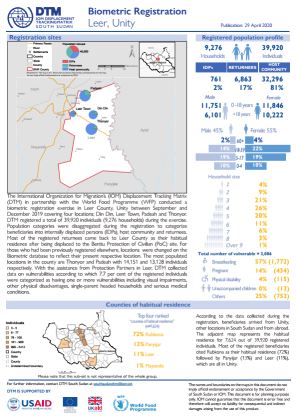
Contact
DTM South Sudan, SouthSudanDTM@iom.int
Language
English
Location
South Sudan
Period Covered
Sep 01 2019
Dec 31 2019
Activity
- Registration
- Biometric Registration
The International Organization for Migration’s (IOM) Displacement Tracking Matrix (DTM) in partnership with the World Food Programme (WFP) conducted a biometric registration exercise in Leer County, Unity between September and December 2019 covering four locations: Din Din, Leer Town, Padeah and Thonyor. DTM registered a total of 39,920 individuals (9,276 households) during the exercise.
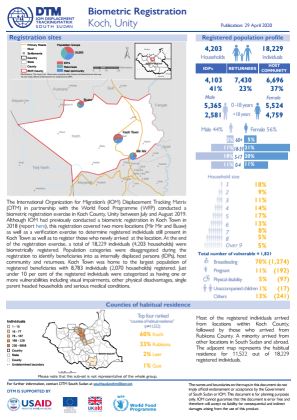
Contact
DTM South Sudan, SouthSudanDTM@iom.int
Language
English
Location
South Sudan
Period Covered
Jul 01 2019
Aug 31 2019
Activity
- Registration
- Biometric Registration
The International Organization for Migration’s (IOM) Displacement Tracking Matrix (DTM) in partnership with the World Food Programme (WFP) conducted a biometric registration exercise in Koch County, Unity between July and August 2019. Although IOM had previously conducted a biometric registration in Koch Town in 2018 (report here), this registration covered two more locations (Mir Mir and Buaw) as well as a verification exercise to determine identify registered individuals still present in Koch Town as well as to register those who newly arrived tat the location. At the end of the exercise, a total of 18,229 individuals (4,203 households) were biometrically registered.

Contact
DTM South Sudan, SouthSudanDTM@iom.int
Language
English
Location
South Sudan
Period Covered
Mar 09 2020
Apr 12 2020
Activity
- Flow Monitoring
The inter-communal fighting that flared up in Jonglei State and Greater Pibor Administrative Area of South Sudan in February 2020 forced over 8,000 people - the majority of whom were women and children - to seek safety in makeshift shelters in the area adjacent to the United Nations Mission in South Sudan (UNMISS) base in Pibor Town. Throughout 9 March to 12 April 2020, IOM tracked a total of 7,416 individual movements newly entering (2,934) and intending to permanently exit (4,482) signifying a net outflux of 1,548 individuals since the start of the exercise. By mid-April, the IDP site adjacent to UNMISS Pibor has seen a sharp decline in its population and partners are beginning to downscale operations.
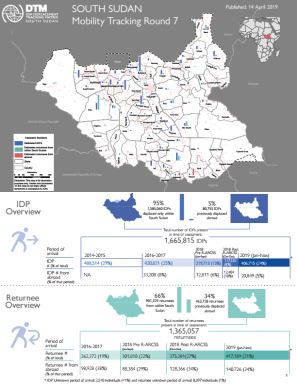
Contact
DTM South Sudan, SouthSudanDTM@iom.int
Language
English
Location
South Sudan
Period Covered
Oct 01 2019
Nov 30 2019
Activity
- Mobility Tracking
- Baseline Assessment
As of November 2019, the internal displacement profile of South Sudan has shifted from being predominantly marked by national conflict. Whilst conflict including national parties are still causing new instances of displacement around Yei in Central Equatoria as well as constituting the main reason for populations remaining in protracted displacement since 2014, new displacement has been increasingly attributed to communal clashes throughout 2018 and 2019 as well as high levels of flooding in the second half of 2019.
DTM makes a difference between political conflict and communal clashes for analysis, however, it should be noted that the lines between livestock-related conflict, other forms of communal tensions and politically motivated violence are frequently blurred. Data collection for round seven took place in October and November 2019 – the height of the 2019 floods –following round six which took place in June 2019. Whilst return movements continue to be observed, these seemed to have peaked during the three months (October – December 2018) following the signing of the Revitalized Agreement on the Resolution of the Conflict in the Republic of South Sudan (R-ARCSS) and have since returned to pre-ARCSS 2018 levels throughout 2019 (in terms of monthly averages of returnee arrivals).

Contact
DTM Iraq, IraqDTM@iom.int
Language
English
Location
Iraq
Period Covered
Jan 01 2020
Feb 29 2020
Activity
- Survey
- Return Intention
- Mobility Tracking
- Baseline Assessment
The Return Index is a tool designed to measure the severity of conditions in locations of return. Data collection for the Return Index Round 8 took place during the months of January and February 2020 across eight governorates, 38 districts and 1,850 locations in Iraq. During Round 8, an additional 98 locations of return were assessed.
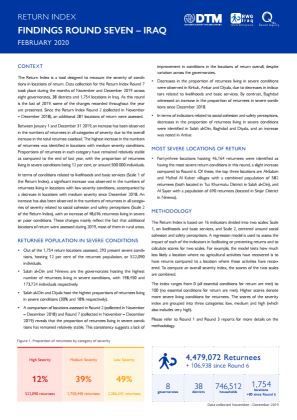
Contact
DTM Iraq, IraqDTM@iom.int
Language
English
Location
Iraq
Period Covered
Jan 01 2019
Dec 31 2019
Activity
- Survey
- Return Intention
- Mobility Tracking
- Baseline Assessment
The Return Index is a tool designed to measure the severity of conditions in locations of return. Data collection for the Return Index Round 7 took place during the months of November and December 2019 across eight governorates, 38 districts and 1,754 locations in Iraq. As this round is the last of 2019, some of the changes recorded throughout the year are presented. Since the Return Index Round 2 (collected in November – December 2018), an additional 281 locations of return were assessed. Between January 1 and December 31 2019, an increase has been observed in the numbers of returnees in all categories of severity due to the overall increase in the total returnee caseload. The highest increase in the numbers of returnees was identified in locations with medium severity conditions. Proportions of returnees in each category have remained relatively stable as compared to the end of last year, with the proportion of returnees living in severe conditions being 12 per cent, or around 500 000 individuals.

Contact
DTM Iraq, IraqDTM@iom.int
Language
English
Location
Iraq
Period Covered
Sep 01 2019
Oct 31 2019
Activity
- Survey
- Return Intention
- Mobility Tracking
- Baseline Assessment
The Return Index is a tool designed to measure the severity of conditions in locations of return. Data collection for the Return Index Round 6 took place during the months of September and October 2019 across eight governorates, 38 districts and 1,674 locations in Iraq. During Round 6, an additional 41 locations of return were assessed.
Pagination
- Previous page
- Page 32
- Next page
